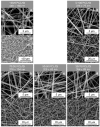Nanostructured Hydrogels by Blend Electrospinning of Polycaprolactone/Gelatin Nanofibers
- PMID: 30036979
- PMCID: PMC6070828
- DOI: 10.3390/nano8070551
Nanostructured Hydrogels by Blend Electrospinning of Polycaprolactone/Gelatin Nanofibers
Abstract
Nanofibrous membranes based on polycaprolactone (PCL) have a large potential for use in biomedical applications but are limited by the hydrophobicity of PCL. Blend electrospinning of PCL with other biomedical suited materials, such as gelatin (Gt) allows for the design of better and new materials. This study investigates the possibility of blend electrospinning PCL/Gt nanofibrous membranes which can be used to design a range of novel materials better suited for biomedical applications. The electrospinnability and stability of PCL/Gt blend nanofibers from a non-toxic acid solvent system are investigated. The solvent system developed in this work allows good electrospinnable emulsions for the whole PCL/Gt composition range. Uniform bead-free nanofibers can easily be produced, and the resulting fiber diameter can be tuned by altering the total polymer concentration. Addition of small amounts of water stabilizes the electrospinning emulsions, allowing the electrospinning of large and homogeneous nanofibrous structures over a prolonged period. The resulting blend nanofibrous membranes are analyzed for their composition, morphology, and homogeneity. Cold-gelling experiments on these novel membranes show the possibility of obtaining water-stable PCL/Gt nanofibrous membranes, as well as nanostructured hydrogels reinforced with nanofibers. Both material classes provide a high potential for designing new material applications.
Keywords: biomaterial; biomedical; hybrid material; nanofibers; nanofibrous membranes; reinforced; scaffolds; thermal analysis.
Conflict of interest statement
The authors declare no conflict of interest.
Figures






References
-
- Bölgen N., Menceloğlu Y.Z., Acatay K., Vargel I., Pişkin E. In vitro and in vivo degradation of non-woven materials made of poly(epsilon-caprolactone) nanofibers prepared by electrospinning under different conditions. J. Biomater. Sci. Polym. Ed. 2005;16:1537–1555. doi: 10.1163/156856205774576655. - DOI - PubMed
-
- Van der Schueren L., De Schoenmaker B., Kalaoglu Ö.I., De Clerck K. An alternative solvent system for the steady state electrospinning of polycaprolactone. Eur. Polym. J. 2011;47:1256–1263. doi: 10.1016/j.eurpolymj.2011.02.025. - DOI
LinkOut - more resources
Full Text Sources
Other Literature Sources
Miscellaneous

